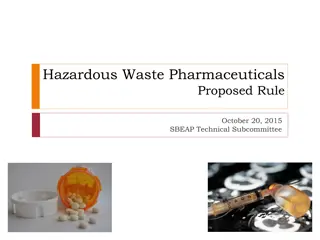Comparison Between HCS and SCS for Waste Collection Efficiency
HCS and SCS are two waste collection systems with specific uses and advantages. HCS is ideal for high generation rate waste removal, eliminating handling time, and allowing flexibility in container sizes. On the other hand, SCS is versatile for all types of wastes but requires more crews, making it more expensive. Collection equipment for HCS and SCS differ in size, capacity, and characteristics, impacting their efficiency and cost-effectiveness.
Download Presentation

Please find below an Image/Link to download the presentation.
The content on the website is provided AS IS for your information and personal use only. It may not be sold, licensed, or shared on other websites without obtaining consent from the author.If you encounter any issues during the download, it is possible that the publisher has removed the file from their server.
You are allowed to download the files provided on this website for personal or commercial use, subject to the condition that they are used lawfully. All files are the property of their respective owners.
The content on the website is provided AS IS for your information and personal use only. It may not be sold, licensed, or shared on other websites without obtaining consent from the author.
E N D
Presentation Transcript
Comparison between HCS, SCS HCS: Used and suitable for: 1.Removal of waste from sources of high G.R. 2. Eliminate handling time of many small container. 3.Eliminate unsightly accumulation associate with the use of a great no. of small container. 4.Flexibility, possibility of using container of different sizes and shapes for all types of wastes. 5.Require only one truck and driver to accomplish collection cycle. 6.Container size is of great economic importance compaction add economic advantages and unloading facilities. SCS: 1.Used for all type of wastes. 2.It vary according to type and quantity of wastes to be handled. 3.It vary according to No. of generation points and the loading process of vehicles. 4. Require more crews so it is more expensive. Generally, collection, equipts for HCS and SCS differ in size and capacity, and characteristics, the following, considered, must be classified. 1.Suitable cover with provision for easy loading and un loading 2.Water tight constant preferably metallic to prevent leakage and spill and easily cleaner. 1
3. Truck capacity depend on waste collection, loading weight, man power requirement. Services organization for collection of S.W in urban areas can be mad by 1. City employees (municipality administrated program) 2. Private firms that contract with municipality. 3. Private firms that contract with private residents. -A city determine what type of S.W to be collected and from whom? In some municipality certain types of wastes demolition are not collected, only garbage is collected. - Hazardous waste are generally excluded from regular collection because of collation dangers. Frequency of collection: - It refers to the No., of collection per week from a specified area or location. - The proper frequency, for the most satisfactory and economical services given by the amount of S.W that must be collected, by climate, cost and public health requirements. - For collection of S.W that conation (garbage) the maximum period between alterative collection shout not be greater than: 1.Normal time for the accumulation of the amount refuse that can be stored in a volume of reasonable size. 2.The time it takes for garbage to putrify and emit foul odors under average storage conditions. 2
3. The length of the fly-breeding cycle, which during hot summer is less than 7 days. The majority frequency in (U.S.A) is once/weak In Iraq frequency of collection better in Summer (2-3) time, and winter once week. Greater frequency of collection is of the following advantages: Cleaner city, convenient for citizens fewer and smaller containers needed, garbage purification, less flies and rodents, more refuse collected, But Cost of collection is high, more equipments and labour requirement. Time of collection: Collection time vary according to the area and source of S.W - In residential areas, collection is done mostly during regular working hours of the day. - Night collection in business area, Market, commercial and Industrial establishment favored. Analysis of collection system - To establish vehicles and labour requires for various collection system and methods. - The unit time required to perform each task in the system must be determined. collection activities (tasks) can be separated into unit operations as follow: 1. Pick Up: definition for SCS and HCS a. SCS: Time spent loading the collection vehicles. 3
b. HCS: Time spent driving to the next container after an empty container has been deposits and the time spent picking up the loaded container and the time requirement to redeposit the container after its contents has been emptied. 2. Haul (H) a.SCS: time required to reach the disposal site starting after the vehicle is filled pluse time after leaving the disposal site until arrival at the location of the next collection route. b. HCS: time required to reach the disposal site starting after loading the container on truck time after leaving the disposal site to the location where the empty container is to be redeposit. 3.At site for HCS and SCS: time spent the disposal site waiting and un loading. 4.Off route: for both system include all time spent on activities that are non productive , such as: - Checking in and out at beginning and end of day work. - Time spent to the first pick up point. - Time spent due to congestion. - Time spent an equipt. repair and Maintenance. - Time spent for lunch in excess of the started period. 4























